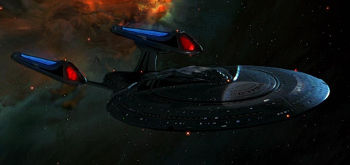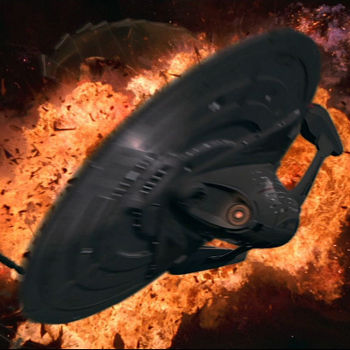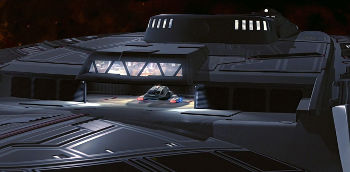Sovereign class (LUG)
| Date Entered Service | 2370[1][2] |
| Length | 685.3m[2] / 732m[1] |
| Width | 250.6m[2] |
| Height | 88.2m[2] |
| Decks | 24[3] |
| Transporters (Personnel) | 6[1][2] |
| Transporers (Emergency) | 6[1][2] |
| Transporters (Cargo) | 8[1][2] |
| Shuttlecraft | 12[2]-16[4], including Captain's Yacht |
| Crew | 855[2] / 1,000[1] |
| Passengers | 5,000[1] |
| Evacuation Limit | 11,000[1] |
| Cruising Speed | Warp 6[2]-7[1] |
| Max. Sustainable Speed | Warp 9.6[1][2] |
| Emergency Speed | Warp 9.682[2]-9.9 for 12 hours[1] |
| Weapons | 6 Type XII Phasers;[4] 2 Type I Pulse Phasers[2] 3 torpedo launchers (1 fore ventral, 1 aft dorsal, 1 aft in saucer);[1] 150 Type II Photon torpedoes;[1]100 Mark II[1] Quantum torpedoes[3] |
Pursuant to Starfleet Exploration Directive 1023.3 the Sovereign class provided a mobile platform for a wide range of ongoing mission profiles. Although its primary mission remained one of exploration and peace, many of the advances incorporated into the ship's design resulted from Starfleet's experiences with the Borg.[1][2] The Sovereign class served a variety of capacities, from long-range exploration to diplomacy, and from combat to research. Able to project Federation policy into neighboring star systems, the class was well-suited to extended deep space missions without starbase support.[4]
Work on the Sovereign class began in 2365, but as the Borg threat became more apparent over the next several years, construction of the class was put on hold as the Starfleet Corps of Engineers (SCE) began to augment and modify the design to counter Borg assaults.[4] With the catastrophic defeat of the fleet at the Battle of Wolf 359, the Advanced Starship Design Bureau (ASDB), in conjunction with the Office of Strategic Operations, Office of Fleed Deployment, and the SCE,[2] launched a number of initiatives to upgrade the tactical capabilities of future starships. Many of these advances, designed for the Intrepid and Defiant classes, were applied to the Sovereign class. Construction of the U.S.S. Sovereign commenced four years after it had been suspended, and additional modifications were made as a result of its shakedown cruise.[4]
Sovereign class (ST09)
Perhaps the most technologically advanced starship ever built by Starfleet, the Sovereign was a throwback to the days of the Constitution class and their ability to "do it all."[4] Incorporating the strategic and tactical reccommendations from the Office of Strategic Operations, the Theoretical Propulsion Group, Tactical Operations Group and Spaceframe Design working groups of Starfleet R&D developed the pulse phaser, the Quantum torpedo, ablative hull plates and new spaceframe structures,[1] which were intended to make the class the leading instrument in Starfleet's plans well into the 25th century.[4] Starfleet's ASDB combined these advancements into several new starship classes, such as the Steamrunner, Saber, and Intrepid classes.[1] The computer and control systems were state-of-the-art, and included the bio-neural gel-pack infrastructure used on Intrepid class vessels. Its sensors were unparalleled, boasting enhanced sensor gain, improved doppler-shift subroutines, and an increase in the variety of sensors available. Two aft shuttlebays housed several support and auxiliary craft, and the Sovereign was equipped with a number of standard, emergency, and cargo transporters.[4] While other, more recent starship designs, such as the Defiant, Steamrunner, and Saber classes, had pulled the warp nacelles closer into the body of the ship, the designers working on the Sovereign class decided to employ the more traditional configuration,[1] although the warp drive was of the new type that no longer distorted the space-time continuum above Warp 5.[2]
Sovereign class shuttlebay (ST09)
The Sovereign class sickbay shared a design substantially similar to that on Intrepid class ships. The entire room was fitted with holographic emitters and had an independent computer system that could project the sophisticated Emergency Medical Hologram, a holographic doctor that was designed to supplement the ship's medical personnel if they were killed, injured, or overwhelmed.[3]
The standard mission duration for a Sovereign class vessel was rated at 7 years, with an estimated 18-year time between system overhauls. Starfleet expected, with progressive upgrades over the lifespan of the spaceframe, the Sovereign class to be a viable design well into the 25th century.[4]
The U.S.S. Sovereign was launched from the San Francisco Fleet Yards in 2370 as a testbed for many of these new technologies. With the destruction of the U.S.S. Enterprise NCC-1701-D in 2371, the next ship off the production line was the U.S.S. Enterprise NCC-1701-E, to continue that venerable line of vessels. The Enterprise, launched in 2372, would be only the second ship in this line, taking its place as the most advanced ship in the fleet.[1] Based on the performance of the Sovereign and the Enterprise, Starfleet Command ordered the construction of additional ships of the class.[4]
Sovereign class vessels
U.S.S. Enterprise NCC-1701-E • U.S.S. Sovereign
Columbia Timeline
U.S.S. Bozeman NCC-1941-A • U.S.S. Enterprise NCC-1701-E • U.S.S. First Minister • U.S.S. Gibraltar NCC-75689 • U.S.S. Musashi • U.S.S. President • U.S.S. Roosevelt • U.S.S. Sovereign NCC-73811 U.S.S. Tempest (Columbia) • U.S.S. Tirpitz • U.S.S. Warspite
LUG Timeline
U.S.S. Enterprise NCC-1701-E • U.S.S. Gibraltar NCC-75689 • U.S.S. Independence NCC-90346 • U.S.S. Sovereign NCC-73811 • U.S.S. Yorktown NCC-90276
SFC Timeline
U.S.S. Affiliation • U.S.S. Agamemnon • U.S.S. Alliance • U.S.S. Association • U.S.S. Consortium • U.S.S. Directorate • U.S.S. Entente • U.S.S. Enterprise NCC-1701-E • U.S.S. Federation • U.S.S. Harrier • U.S.S. Solidarity • U.S.S. Sovereign • U.S.S. Unification • U.S.S. Unity
STA Timeline
U.S.S. Enterprise NCC-1701-E • U.S.S. Sovereign NCC-73811
STO Timeline
U.S.S. Enterprise NCC-1701-E • U.S.S. Sovereign NCC-74977 • U.S.S. Sovereign NCC-74977-A
Mirror Universe
I.S.S. Enterprise NCC-1701-E (Columbia-M2) • I.S.S. Enterprise NCC-1701-E (SVM) • I.S.S. Sovereign NC-30478 (STO-M)
Myriad Universes
U.S.S. Bozeman NCC-1941-A (SL) • U.S.S. Constellation (SV) • U.S.S. Davis NCC-74967 (Legacy) • U.S.S. Erebus (SV) • U.S.S. Legacy NCC-75001 (Legacy)
Armada
U.S.S. Aeon (Arma) • U.S.S. Alexandra (Arma) • U.S.S. Archangel (Arma) • U.S.S. Aries (Arma) • U.S.S. Atlas NCC-82745 (Arma) • U.S.S. Avalon (Arma) • U.S.S. Avatar (Arma) • U.S.S. Calabria (Arma) • U.S.S. Challenger (Arma) • U.S.S. Coburn (Arma) • U.S.S. Danvers (Arma) • U.S.S. Destiny (Arma) • U.S.S. Endurance (Arma) • U.S.S. Faithful (Arma) • U.S.S. Formidable (Arma) • U.S.S. Hickey (Arma) • U.S.S. Hope (Arma) • U.S.S. Horizon (Arma) • U.S.S. Hyperion (Arma) • U.S.S. Integrity (Arma) • U.S.S. Justice (Arma) • U.S.S. Legacy NCC-75001 (Arma) • U.S.S. Leviathan (Arma) • U.S.S. Majestic (Arma) • U.S.S. Midway (Arma) • U.S.S. Nimitz (Arma) • U.S.S. Odin (Arma) • U.S.S. Oxford (Arma) • U.S.S. Providence (Arma) • U.S.S. Rand (Arma) • U.S.S. Saratoga (Arma) • U.S.S. Sentinel NCC-1733-B (Arma) • U.S.S. Tempest (Arma) • U.S.S. Tiberius (Arma) • U.S.S. Wellington (Arma) • U.S.S. Yamato NCC-75808 (Arma)
Birth of the Federation
U.S.S. Antietam (BotF) • U.S.S. Ark Royal (BotF) • U.S.S. Bismarck (BotF) • U.S.S. Brigadier (BotF) • U.S.S. Colossus (BotF) • U.S.S. Croatan (BotF) • U.S.S. Essex (BotF) • U.S.S. Leviathan (BotF) • U.S.S. Lorraine (BotF) • U.S.S. Magnificent (BotF) • U.S.S. Marshall (BotF) • U.S.S. Midway (BotF) • U.S.S. Monterey (BotF) • U.S.S. Musashi (BotF) • U.S.S. Nelson (BotF) • U.S.S. Princeton (BotF) • U.S.S. Provence (BotF) • U.S.S. Ramillies (BotF) • U.S.S. Resolution (BotF) • U.S.S. Richelieu (BotF) • U.S.S. Roosevelt (BotF) • U.S.S. Sevastopol (BotF) • U.S.S. Tirpitz (BotF) • U.S.S. Valiant (BotF) • U.S.S. Vanguard (BotF) • U.S.S. Yamashiro (BotF) • U.S.S. Zuikaku (BotF)
Notes and References
- ↑ 1.00 1.01 1.02 1.03 1.04 1.05 1.06 1.07 1.08 1.09 1.10 1.11 1.12 1.13 1.14 1.15 1.16 1.17 1.18 Isaacs, Ross A. (Line Developer). The Price of Freedom: The United Federation of Planets Sourcebook. Star Trek: The Next Generation Roleplaying Game. Book 25100 . Written by Brian Campbell, Heather Curatola, Harry Heckel, Kenneth A. Hite, Ross A. Isaacs, Steve Long, Christian Moore, Nicky Rea, Aaron Rosenberg, John Snead, and Ray Winninger. Original art by Bryan Gibson. Last Unicorn Games, Inc.. February 1999.
- ↑ 2.00 2.01 2.02 2.03 2.04 2.05 2.06 2.07 2.08 2.09 2.10 2.11 2.12 2.13 2.14 2.15 Heinig, Jess (Line Developer). Starfleet Operations Manual. Star Trek Roleplaying Game. Book 3 . Written by Kenneth Hite. Original Art by C. Brent Ferguson and David Pipgras. Decipher, Inc.. 2003.
- ↑ 3.0 3.1 3.2 Berman, Rick (Producer). Star Trek: First Contact. Directed by Jonathan Frakes. Story by Rick Berman & Brannon Braga & Ronald D. Moore. Screenplay by Brannon Braga & Ronald D. Moore. Paramount Pictures. 22 November 1996.
- ↑ 4.0 4.1 4.2 4.3 4.4 4.5 4.6 4.7 4.8 4.9 Heinig, Jess Ross A. Isaacs (Line Developers). Starships. Star Trek Roleplaying Game. Book 4. Written by Bill Bridges, Andrew Greenberg, Kenneth Hite, Ross A. Isaacs, and Doug Sun. Illustrations by David Pipgras. Decipher, Inc.. 2003.



